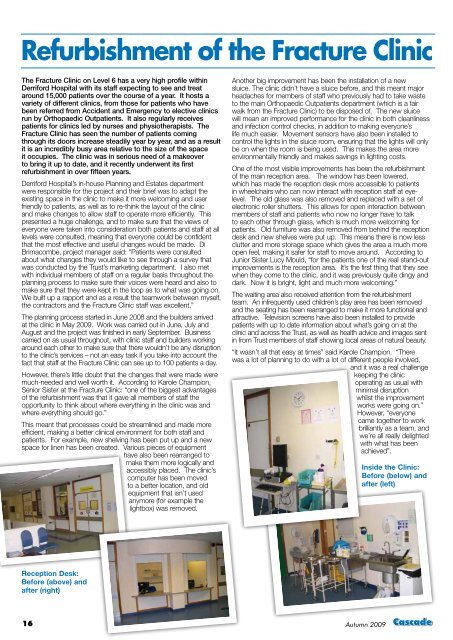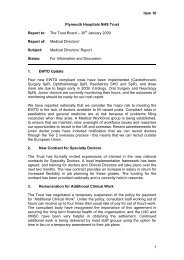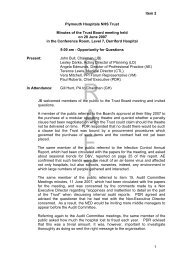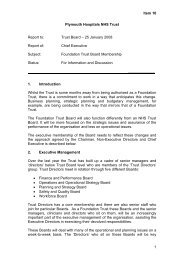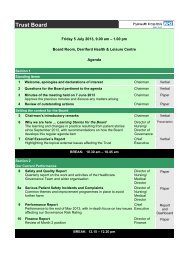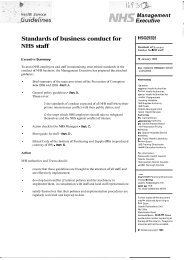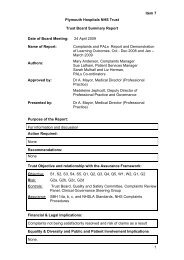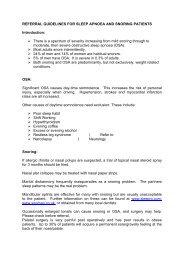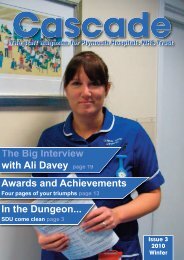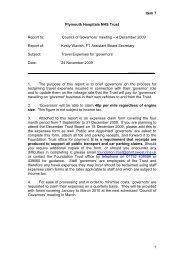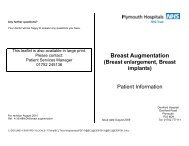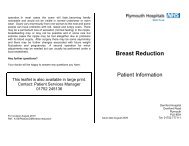Military Cross Award for Naval Medical Assistant Kate Nesbitt
Military Cross Award for Naval Medical Assistant Kate Nesbitt
Military Cross Award for Naval Medical Assistant Kate Nesbitt
Create successful ePaper yourself
Turn your PDF publications into a flip-book with our unique Google optimized e-Paper software.
Refurbishment of the Fracture Clinic<br />
The Fracture Clinic on Level 6 has a very high profile within<br />
Derri<strong>for</strong>d Hospital with its staff expecting to see and treat<br />
around 15,000 patients over the course of a year. It hosts a<br />
variety of different clinics, from those <strong>for</strong> patients who have<br />
been referred from Accident and Emergency to elective clinics<br />
run by Orthopaedic Outpatients. It also regularly receives<br />
patients <strong>for</strong> clinics led by nurses and physiotherapists. The<br />
Fracture Clinic has seen the number of patients coming<br />
through its doors increase steadily year by year, and as a result<br />
it is an incredibly busy area relative to the size of the space<br />
it occupies. The clinic was in serious need of a makeover<br />
to bring it up to date, and it recently underwent its first<br />
refurbishment in over fifteen years.<br />
Derri<strong>for</strong>d Hospital’s in-house Planning and Estates department<br />
were responsible <strong>for</strong> the project and their brief was to adapt the<br />
existing space in the clinic to make it more welcoming and user<br />
friendly to patients, as well as to re-think the layout of the clinic<br />
and make changes to allow staff to operate more efficiently. This<br />
presented a huge challenge, and to make sure that the views of<br />
everyone were taken into consideration both patients and staff at all<br />
levels were consulted, meaning that everyone could be confident<br />
that the most effective and useful changes would be made. Di<br />
Brimacombe, project manager said: “Patients were consulted<br />
about what changes they would like to see through a survey that<br />
was conducted by the Trust’s marketing department. I also met<br />
with individual members of staff on a regular basis throughout the<br />
planning process to make sure their voices were heard and also to<br />
make sure that they were kept in the loop as to what was going on.<br />
We built up a rapport and as a result the teamwork between myself,<br />
the contractors and the Fracture Clinic staff was excellent.”<br />
The planning process started in June 2008 and the builders arrived<br />
at the clinic in May 2009. Work was carried out in June, July and<br />
August and the project was finished in early September. Business<br />
carried on as usual throughout, with clinic staff and builders working<br />
around each other to make sure that there wouldn’t be any disruption<br />
to the clinic’s services – not an easy task if you take into account the<br />
fact that staff at the Fracture Clinic can see up to 100 patients a day.<br />
However, there’s little doubt that the changes that were made were<br />
much-needed and well worth it. According to Karole Champion,<br />
Senior Sister at the Fracture Clinic: “one of the biggest advantages<br />
of the refurbishment was that it gave all members of staff the<br />
opportunity to think about where everything in the clinic was and<br />
where everything should go.”<br />
This meant that processes could be streamlined and made more<br />
efficient, making a better clinical environment <strong>for</strong> both staff and<br />
patients. For example, new shelving has been put up and a new<br />
space <strong>for</strong> linen has been created. Various pieces of equipment<br />
have also been rearranged to<br />
make them more logically and<br />
accessibly placed. The clinic’s<br />
computer has been moved<br />
to a better location, and old<br />
equipment that isn’t used<br />
anymore (<strong>for</strong> example the<br />
lightbox) was removed.<br />
Another big improvement has been the installation of a new<br />
sluice. The clinic didn’t have a sluice be<strong>for</strong>e, and this meant major<br />
headaches <strong>for</strong> members of staff who previously had to take waste<br />
to the main Orthopaedic Outpatients department (which is a fair<br />
walk from the Fracture Clinic) to be disposed of. The new sluice<br />
will mean an improved per<strong>for</strong>mance <strong>for</strong> the clinic in both cleanliness<br />
and infection control checks, in addition to making everyone’s<br />
life much easier. Movement sensors have also been installed to<br />
control the lights in the sluice room, ensuring that the lights will only<br />
be on when the room is being used. This makes the area more<br />
environmentally friendly and makes savings in lighting costs.<br />
One of the most visible improvements has been the refurbishment<br />
of the main reception area. The window has been lowered,<br />
which has made the reception desk more accessible to patients<br />
in wheelchairs who can now interact with reception staff at eyelevel.<br />
The old glass was also removed and replaced with a set of<br />
electronic roller shutters. This allows <strong>for</strong> open interaction between<br />
members of staff and patients who now no longer have to talk<br />
to each other through glass, which is much more welcoming <strong>for</strong><br />
patients. Old furniture was also removed from behind the reception<br />
desk and new shelves were put up. This means there is now less<br />
clutter and more storage space which gives the area a much more<br />
open feel, making it safer <strong>for</strong> staff to move around. According to<br />
Junior Sister Lucy Mould, “<strong>for</strong> the patients one of the real stand-out<br />
improvements is the reception area. It’s the first thing that they see<br />
when they come to the clinic, and it was previously quite dingy and<br />
dark. Now it is bright, light and much more welcoming.”<br />
The waiting area also received attention from the refurbishment<br />
team. An infrequently used children’s play area has been removed<br />
and the seating has been rearranged to make it more functional and<br />
attractive. Television screens have also been installed to provide<br />
patients with up to date in<strong>for</strong>mation about what’s going on at the<br />
clinic and across the Trust, as well as health advice and images sent<br />
in from Trust members of staff showing local areas of natural beauty.<br />
“It wasn’t all that easy at times” said Karole Champion. “There<br />
was a lot of planning to do with a lot of different people involved,<br />
and it was a real challenge<br />
keeping the clinic<br />
operating as usual with<br />
minimal disruption<br />
whilst the improvement<br />
works were going on.”<br />
However, “everyone<br />
came together to work<br />
brilliantly as a team, and<br />
we’re all really delighted<br />
with what has been<br />
achieved”.<br />
Inside the Clinic:<br />
Be<strong>for</strong>e (below) and<br />
after (left)<br />
Reception Desk:<br />
Be<strong>for</strong>e (above) and<br />
after (right)<br />
16 Cascade<br />
Autumn 2009


